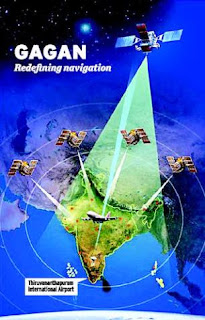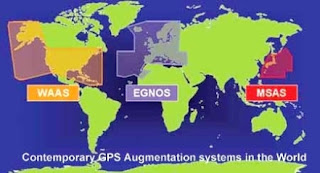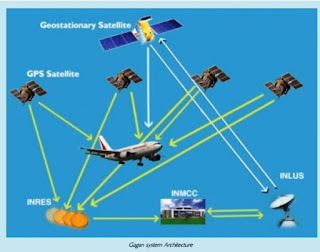GAGAN - Satellite Based Navigation System
 The time has come that we must move away from the American Global Navigation Satellite System (GNSS) or Global Positioning System (GPS) and make way for our own desi navigation system — the Indian Regional Navigation Satellite System (IRNSS) on our mobile phones/tabs/other navigation devices.
The time has come that we must move away from the American Global Navigation Satellite System (GNSS) or Global Positioning System (GPS) and make way for our own desi navigation system — the Indian Regional Navigation Satellite System (IRNSS) on our mobile phones/tabs/other navigation devices.The GPS Aided GEO Augmented Navigation (GAGAN) is an implementation of a regional Satellite-Based Augmentation System (SBAS) by the Indian government. It is a system to improve the accuracy of a GNSS receiver by providing reference signals. The efforts of Airport Authority of India (AAI) towards the implementation of operational SBAS can be viewed as the first step towards introduction of modern communication, navigation, surveillance/Air Traffic Management system over Indian airspace.
Introduction
GAGAN is a satellite based navigation system that will serve as a low cost substitute for Instrument Landing System (ILS). The system is being developed by ISRO in collaboration with Airports Authority of India.
GAGAN will use a satellite based Wide Area Augmentation System (WAAS) technology (Satellite based WAAS is also referred to as Satellite Based Augmentation Systems or SBAS) developed by Raytheon for the US Federal Aviation Authority (FAA).
WAAS is a ground and space-based network that provides corrections for GPS signals so they can yield more precision in all modes of transportation, including civil aviation. Lateral Precision with Vertical (LPV) guidance on the WAAS, facilitates civil aircraft to make an instrumented approach for landing with cloud ceilings as low as 250 ft. and visibility as low as 0.75 mi. This compares well with a typical ILS that allows an aircraft to make an instrumented approach with a cloud ceiling as low as 200 ft. and visibility as low as 0.50.
The Way GAGAN Works
The GAGAN system consists of a network of 15 Indian Navigation Reference Earth Stations (INRES) spread over the country that are precisely surveyed to compare the position determined from GPS satellite signals against the location of the receiver. The observed deltas are then be sent to 2 Indian Navigation Master Control Centers (INMCC) where computer processing will extrapolate the data to generate correcting deltas for GPS signals anywhere within the network.
These correcting deltas will be relayed via 3 Indian Navigation Land Uplink Stations (INLUS) and geostationary satellites to civil aircraft so more precise fixes of their position can be derived from GPS satellite signals.
INRES sites and INMCCs are connected using Optical Fiber Cable Data Communication Network as well as VSAT link.
ISRO will launch and manage the data link satellites.
The cost savings in using a system like GAGAN accrue from the fact that its ground system does not need to be duplicated for each runway, as is the case for an ILS. The GPS signals, as well as the correcting deltas, can be made available to aircraft for any runway within the network using satellite based communication.
GAGAN Accuracy
GAGAN will provide a precision of 1.5-meter accuracy in the horizontal plane, 2.5-meter in the vertical. This is the same as the FAA system. However, to account for possible worst-case positioning errors in civil aviation, a much rougher figure of about 15 meters horizontal will be used.
In addition to using GPS signals, GAGAN will be able to use timing and positioning signals from GLONASS and the proposed GALILEO Navigation Satellite System..
Implementation Progress
In January 2014, DGCA certified the GAGAN system to RNP0.1 (Required Navigation Performance 0.1 Nautical Mile) service level clearing the use of the system by aircraft equipped with the Satellite Based Augmentation System (SBAS) in Indian airspace for en route navigation and non-precision approaches without vertical guidance.
According to ISRO, The GAGAN System is poised to APV1/1.5 level of certification in the near future, facilitating precision approach services over the Indian land mass.
The GAGAN signal is currently being broadcast through two Geostationary Earth Orbit (GEO) satellites - GSAT8 and GSAT10 - covering whole Indian Flight Information Region (FIR) and beyond.
The GAGAN system will have a full complement of the SBAS inclusive of ground and onboard segment. It is being built in phases.
The first phase was completed in August 2007 and served as a technology demonstrator.
Final operation phase implementation started in June 2009; completion was scheduled by July 2013.
The space borne segment of GAGAN consists of payloads onboard Indian geostationary satellites GSAT-8P, GSAT-10 and GSAT-15.
The GSAT-8P was successfully launched using Ariane 5 on May 21, 2011 and is positioned in geosynchronous orbit at 55 degrees E longitude.
After the launch of GSAT-8, In-Orbit Test and Test and Evaluation of GAGAN navigation payload were carried out and the satellite integrated with Bangalore INLUS-West. Stability test were conducted, following which GAGAN signal without certification became available for users.
GSAT-10 was launched on September 29, 2012 and was integrated with Bangalore INLUS-East. Also, GSAT-8 was integrated with New Delhi INLUS. Final System Acceptance Test was scheduled for June 2012 followed by system certification during July 2013.
An on-orbit spare GAGAN transponder will be flown on GSAT-15.
GAGAN can function with one Geo stationary satellite. The other two satellites serve as in-orbrit backups.
Aircraft Equipment
In order to use GAGAN, aircraft will need to be equipped with a small receiver with three antennas costing $2,000 - $5,000.
Ionospheric Study
One essential component of the GAGAN project is the study of the ionospheric behavior over the Indian region. This has been specially taken up in view of the rather uncertain nature of the behavior of the ionosphere in the region. The study will lead to the optimization of the algorithms for the ionospheric corrections in the region.
Planned Usage
India plans to use the GAGAN system initially in 40 candidate airports that will require CAT-1 or close to CAT-1 capability in the near future.
The system will improve airport and airspace access in all-weather conditions while meeting environmental and obstacle clearance constraints.
GAGAN would also enhance reliability and reduce delays by defining more precise terminal area procedures that feature parallel routes and environmentally optimised airspace corridors.
Flight Management System (FMS)
A Flight Management System (FMS), based on GAGAN, is under development. It will help civil aircraft operators to save time and money by managing climb, descent and engine performance profiles of aircraft.
Compatibility
 |
| GAGAN will be compatible with other GPS augmentation systems under development. (Photo Credit: ISRO) |
GAGAN will be compatible with other Space Based Augmentation System such as the Wide Area Augmentation System of the U.S., the European Geostationary Navigation Overlay Service and the Multi-functional Satellite Augmentation System of Japan and will provide seamless air navigation service across regional boundaries.
India would become the fourth country in the world to adopt this system.
National Institute for Aeronautics and Space (LAPAN) of Indonesia has expressed interest in Gagan.


0 comments:
Post a Comment